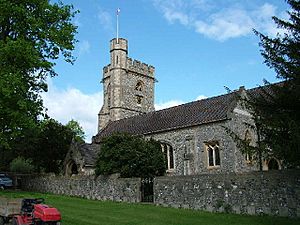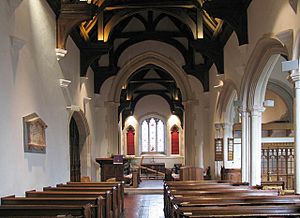St Michael's, Chenies facts for kids
St Michael's Church in Chenies, Buckinghamshire, is a very old and important Anglican church. It might not be famous for its design, but it sits in a beautiful spot near the Chenies Manor House. The church is well-known for its special Bedford Chapel, which is a private burial place for the Russell family, who are the Dukes of Bedford from Woburn Abbey. This chapel is not open to the public.
Contents
About the Parish Church
Church History
The church you see today was mostly built in the late 1400s and early 1500s. It replaced an older church from the 1100s, which was mainly made of wood. The very first church here, dedicated to St. Michael, was likely built by Alexander de Isenhampstead in the late 1100s. "Isenhampstead" was the original name of the village, which later became "Isenhampstead Chenies" and then just "Chenies."
In 1556, the Russell family added the Bedford Chapel. This chapel was later rebuilt and made bigger. The church needed a lot of repairs in the 1700s. So, in 1829, Lord Wriothesley Russell, who was the church's Rector for 57 years, started a big repair project. The church had to close for a few years in the 1830s. During this time, his father, the 6th Duke of Bedford, let people use the Long Room at Chenies Manor House for church services. St Michael's Church was fully repaired and reopened on June 23, 1836.
Another major renovation happened between 1861 and 1887, when much of the church was rebuilt. In 1885, the Bedford Chapel was made longer towards the tower. In 1886-1887, the roof was raised, and the current hammer beam roof was put in. The Bedford Chapel was extended again in 1906. A special room for the bell ringers was added in 1933. Before that, the ringers stood at the bottom of the tower, on the same level as the main church area. Electric lights were installed for the first time in 1936. In 1959-1960, a storm damaged the organ, and a new one was installed in 1960. The new organ's control panel is still in the southeast corner of the main church area.
What the Church Looks Like
The main parts of the church, like the chancel (area around the altar), nave (main seating area), south aisle (side section), and west tower, are from the 1400s. The north chapel, which is the Bedford Chapel, was added in 1556. Most of the walls are made of flint stones with stone details. The west tower has a spiral staircase on its southeast side. The outside flint walls were redone in the 1860s.
Inside the church, there are many interesting things to see. On the north side, an archway leads from the nave into the Bedford Chapel. There is a very old 1100s font, which is a basin used for baptisms, in the 'Aylesbury' style from the Norman period. You can also see medieval brass plaques and beautiful Victorian windows.
The Bedford Chapel
Chapel Description
The Bedford Chapel is the private burial place for the Russell family, the Dukes of Bedford. Even though it's part of St. Michael's Church, it's managed by Woburn Abbey. It is not open to the public, but you can see inside through a glass screen from the church. The chapel holds many impressive funeral monuments. The famous historian Nikolaus Pevsner said it has "as rich a store of funeral monuments as any parish church of England."
The Bedford Chapel is on the north side of St Michael's Church. It was built in 1556 by Anne Sapcote, who was the wife of John Russell, 1st Earl of Bedford. She built it following her husband's wishes. A stone tablet on the outside east wall of the chapel says: "Anno Dni 1556 / Thys Chappel ys, built by Anne / Countysse of Bedforde wyfe to / John Erle of Bedford accordyg to / ye last wyll of the sayd erle."
The monuments in the Bedford Chapel range from the 1400s to detailed sculptures from the 1600s, and even one for the 9th Duke of Bedford who passed away in 1891. The Russell family's flags and banners hang from the walls. Ten special painted shields, called funeral hatchments, are fixed to the roof. All the statues of people lying down in the chapel have their feet pointing away from the East. Several small crowns are placed high up on the South wall.
The floor of the Bedford Chapel is made of black and white marble. It has an open wooden roof with hammer beams. The ends of the wooden supports are decorated with half-figures of angels holding colorful shields of the Russell family and related families. The six stained-glass windows on the north side were made by C.E. Kempe around 1897. On the floor of the chancel, you can see the helmet and sword that belonged to the 7th Duke of Bedford. These items hung over his special seat in St George's Chapel, Windsor Castle because he was a Knight of the Garter. The large East window is dedicated to the 9th Duke of Bedford and his wife Elizabeth. A carved stone crest on the outside of the West gable wall also honors them. The 9th Duke and his wife were early supporters of cremation. They even helped pay for the building of Woking Crematorium. Their ashes are buried in the Bedford Chapel, as are those of Herbrand Russell, 11th Duke of Bedford, who led the Cremation Society of Great Britain from 1921 until his passing in 1940.
In 1868, a new parish church was finished near Woburn Abbey in Woburn, Bedfordshire. It had a crypt (an underground room) that was meant to be the burial place for the Dukes of Bedford and their family. However, the Russell family continued to use the old mausoleum at Chenies. The crypt of St. Mary's parish church in Woburn is now used for events. You can still see the opening through which coffins would have been lowered into the crypt.
Lady Amberley, the wife of Viscount Amberley, passed away in 1874. Her daughter Rachel passed away five days later. Viscount Amberley decided to have their bodies cremated without a religious ceremony, which was unusual for the time. Lady Amberley's ashes were first placed in the grounds of their home. All three sets of remains were later moved to the Bedford Chapel shortly after Lord Amberley's own passing in 1876.
Important Monuments
The Bedford Chapel is famous for its many monuments to the Earls and Dukes of Bedford from the Russell family. Most of them are buried in the vault beneath the chapel. Some of the most important monuments include:
- A monument for John Russell, 1st Earl of Bedford (who passed away in 1555) and his wife Anne Sapcote (who passed away in 1559). It is a stone chest with statues of them.
- A monument for Bridget Hussey (who passed away in 1600). She was the wife of the Francis Russell, 2nd Earl of Bedford. Her tomb, with her statue, was moved to the Bedford Chapel in 1907.
- A monument for Anne Russell, Countess of Warwick (who passed away in 1604). It is a tomb chest with her statue.
- A monument for Elizabeth Russell, Lady Russell of Thornhaugh (who passed away in 1611). This was also moved from Watford in 1907.
- A monument for Lady Frances Bourchier (who passed away in 1612). She passed away at age 25 and was not married. Her monument is in the middle of the chapel. It has a black marble slab supported by four white marble columns, forming a canopy over another black marble slab.
- A monument for Francis Russell, 2nd Earl of Bedford (who passed away in 1619). It is a tomb chest with statues made by William Cure II.
- A monument for Lady Frances Clinton (who passed away in 1623). She is shown as a figure resting on a base.
- A monument for Francis Russell, 4th Earl of Bedford (who passed away in 1641) and his wife Catherine Brydges (who passed away in 1657). It is a tomb chest with alabaster statues of them.
- A monument for William Russell, 1st Duke of Bedford (who passed away in 1700). It features marble columns with oval portraits and two life-size seated figures.
- A monument for Wriothesley Russell, 2nd Duke of Bedford (who passed away in 1711) and his wife Elizabeth Howland. This monument was made in 1769.
- A memorial for Lady Georgiana Russell (who passed away in 1858). It shows a praying lady in profile.
- A monument for John Russell, 1st Earl Russell (who passed away in 1878).
- A monument for Odo Russell, 1st Baron Ampthill (who passed away in 1884).
- A monument for Francis Russell, 9th Duke of Bedford (who passed away in 1891).
- A memorial for Lord Arthur Russell (who passed away in 1892). This memorial is in the chapel, but he is buried in London.
- A 14th-century monument for a member of the Cheyne family, who were the medieval lords of Chenies, and his wife. It is a table tomb with statues, but the male statue was never finished.
Churchyard
St. Michael's Church is surrounded by the parish cemetery. The Churchyard Extension has the war grave of an airman from World War II, Aircraftsman 2nd Class John Lionel Crook, who passed away on December 12, 1944.






